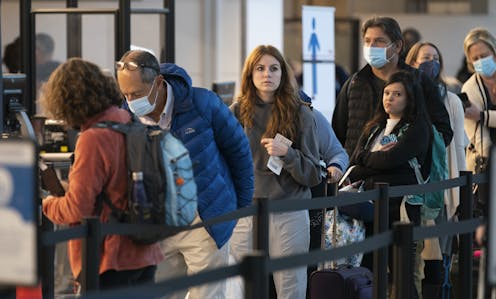Should you wear a mask on a plane, bus or train when there's no mandate? 4 essential reads to help you decide

On April 18, 2022, a judge in Florida struck down the federal mandate requiring passengers on mass transit to wear masks. While the U.S. Centers for Disease Control and Prevention still recommends that passengers mask up while on planes, trains or buses, it is no longer a requirement. When asked whether people should wear masks on planes, President Joe Biden replied: “That’s up to them.”
The Conversation has been covering the science of masks since the beginning of the pandemic. Masking may no longer be required on mass transit, but you can always choose to still wear a mask. For those worried about being exposed to SARS-CoV-2 or developing COVID-19, below are highlights from four articles exploring the benefits of wearing a mask and how to get the most protection from wearing one.
1. Masks can protect the person wearing them
A lot of the reason for wearing a mask is to protect others. But early on in the pandemic, Monica Gandhi, a professor of medicine at the University of California, San Francisco, explained how masks can protect the wearer, too.
“When you wear a mask – even a cloth mask – you typically are exposed to a lower dose of the coronavirus than if you didn’t,” Gandhi writes. “Both recent experiments in animal models using coronavirus and nearly a hundred years of viral research show that lower viral doses usually mean less severe disease.”
Though it’s only one of many factors, “the amount of virus that you’re exposed to – called the viral inoculum, or dose – has a lot to do with how sick you get. If the exposure dose is very high, the immune response can become overwhelmed,” explains Gandhi. “On the other hand, if the initial dose of the virus is small, the immune system is able to contain the virus.”
Read more: Cloth masks do protect the wearer – breathing in less coronavirus means you get less sick
The better the mask, the lower the exposure dose. And in the many months since Gandhi wrote that story, a lot of work has been done to determine which kinds of masks are most effective.

2. What makes for a good mask?
The first thing to consider when wearing a mask is whether it’s a good one. Christian L'Orange is a professor of mechanical engineering and has been testing different masks for the state of Colorado since the pandemic started. He explains that there are two things that make for a protective mask. “First, there’s the ability of the material to capture particles. The second factor is the fraction of inhaled or exhaled air leaking out from around the mask – essentially, how well a mask fits.”
When it comes to these two attributes, L'Orange says, “the N95 and KN95 masks are the best option.” This performance has a lot to do with the materials they are made from. “These fibers are very tightly packed together so the gaps a particle must navigate through are very small. This results in a high probability that particles will end up touching and sticking to a fiber as they pass through a mask. These polypropylene materials also often have a static charge that can help attract and catch particles.”
Fit is the second important factor for a mask. As L'Orange writes, “a mask can offer protection only if it doesn’t leak.” N95s and KN95s are stiff and seal much better than other masks.
If you don’t have access to an N95 or KN95, surgical masks should be your second choice. They are made of densely woven material, but they don’t seal perfectly. Cloth masks should be your last choice because of their generally loose weave and bad fit. But there are ways to improve the performance of surgical and cloth masks.
3. How to make a mask fit well
“No matter how good a mask’s material is, it won’t work well if it doesn’t fit well,” writes Scott Schiffres, a mechanical engineer at Binghamton University.
There are two ways to improve the fit and performance of surgical and cloth masks. The first, explains Schiffres, is simply wearing two masks. “Double-masking is wearing a cotton mask over a medical-procedure mask.” This can greatly improve the fit and add a little bit more filtration. The second approach is to knot and tuck a surgical mask so that it fits better.
As Schiffres explains in his article, “Knotting and tucking entails tying a knot in the elastic loops that go over your ears, close to where they attach to the mask. Then, you tuck the extra mask fabric into the gap that is often present where the ear loops attach to the mask, and flatten that part as much as possible. Both of these tricks make a better fit and decrease the mask-wearers’ exposure to potentially infectious aerosols by 95% as compared with wearing no mask at all. That’s a 15% improvement over the 80% efficiency found when using a single surgical mask.
Read more: CDC says masks must fit tightly – and two are better than one
4. Breakthrough cases and new variants
The final consideration when deciding to wear a mask isn’t about you. Doing so can protect others.
Sara Sawyer, Arturo Barbachano-Guerrero and Cody Warren are virologists and biologists at the University of Colorado Boulder. In a recent story, they write that omicron "is often able to evade existing immunity long enough to start an infection, cause symptoms and transmit onward to the next person.” “This explains why reinfections and vaccine breakthrough infections seem to be more common with omicron.”
Case numbers are low for now, and therefore so is the risk of catching or transmitting the coronavirus. But it is not zero; some places have higher risk than others, and new variants can come on quickly. As the team writes, all new variants that spread widely – so-called variants of concern – are likely to be highly transmissible.
The person next to you on the plane might not be wearing a mask and, as it stands, that is their choice to make. If you want to lower your own chances of catching or spreading the coronavirus, there are still a number of reasons to wear a well-fitting, high-quality mask.
Editor’s note: This story is a roundup of articles from The Conversation’s archives.
from The Conversation – Articles (US) https://ift.tt/Co8tgsH
 Reviewed by Admin
on
April 20, 2022
Rating:
Reviewed by Admin
on
April 20, 2022
Rating:




No comments: